
Graphium is a genus of mostly tropical swallowtail butterflies commonly known as swordtails, kite swallowtails, or ladies. Native to Eurasia, Africa, and Oceania, the genus is represented by over 100 species. Their colouration is as variable as the habitats they frequent; from rainforest to savannah. Some possess tails which may be long and swordlike, while others lack any hindwing extensions. Graphium species are often sighted at mud puddles.

Graphium agamemnon, the tailed jay, is a predominantly green and black tropical butterfly that belongs to the swallowtail family. The butterfly is also called the green-spotted triangle, tailed green jay, or green triangle. It is a common, non-threatened species native to Nepal, India, Sri Lanka through Southeast Asia and Australia. Several geographic races are recognized. The species was first described by Carl Linnaeus in his 1758 10th edition of Systema Naturae.
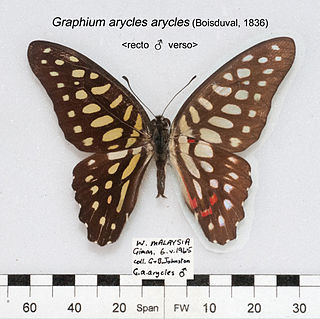
Graphium arycles, the spotted jay, is a species of butterfly of the family Papilionidae found in the Indomalayan realm.

Graphium eurypylus, the great jay or pale green triangle, is a species of tropical butterfly belonging to the family Papilionidae.

Graphium angolanus, the Angola white lady, is a species of butterfly in the family Papilionidae (swallowtails). It is found in Sub-Saharan Africa.

Graphium morania, the white lady or small white-lady swordtail, is a species of butterfly in the family Papilionidae (swallowtails). It is found in southern Africa.
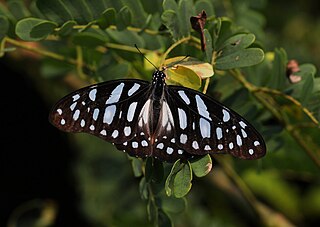
Graphium leonidas, the veined swordtail, veined swallowtail or common graphium, is a species of butterfly in the family Papilionidae, found in Sub-Saharan Africa.

Graphium antheus, the large or larger striped swordtail, is a species of butterfly in the family Papilionidae (swallowtails), found in tropical and sub-Saharan Africa.

Graphium policenes, the common swordtail or small striped swordtail, is a species of butterfly in the family Papilionidae (swallowtails). It is found in tropical Africa.
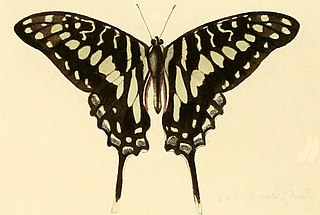
Graphium porthaon, the coastal swordtail, cream-striped swordtail or dark swordtail, is a species of butterfly in the family Papilionidae, found in tropical western Africa.

Graphium illyris, the cream-banded swordtail, is a forest butterfly of the swallowtail family (Papilionidae). It is native to the Afrotropical realm.

Graphium evombar is a butterfly in the family Papilionidae. It is found on Madagascar and the Comoros. The habitat consists of forests.

Graphium policenoides is a butterfly in the family Papilionidae (swallowtails). It is found in Cameroon, Gabon, the Republic of the Congo and the Democratic Republic of the Congo. Its habitat consists of wet forests in good condition. It is very similar to Graphium policenes and Graphium liponesco
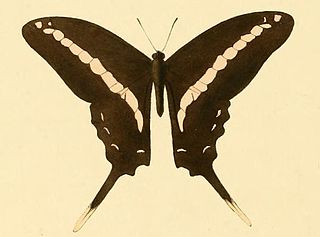
Graphium kirbyi, the Kirby's swordtail, is a butterfly in the family Papilionidae. It is found along the coast of Kenya and from the coast of Tanzania, inland to Morogoro. The habitat consists of coastal forests.

Graphium junodi, the Junod's swordtail, is a butterfly in the family Papilionidae. It is found in Angola, the Democratic Republic of the Congo, Uganda, Tanzania, Mozambique and along the eastern border of Zimbabwe. The habitat consists of warm forests.

Graphium polistratus, the dancing swordtail, is a butterfly in the family Papilionidae (swallowtails). It is found in Nigeria, the Democratic Republic of the Congo, the coast of Kenya, Tanzania, northern Malawi and Mozambique. Its habitat consists of warm and coastal forests.

Graphium ridleyanus, the acraea swordtail, is a butterfly in the family Papilionidae (swallowtails). It is found in eastern Nigeria, Cameroon, Equatorial Guinea, Sao Tome and Principe, Gabon, the Republic of the Congo, Angola, the Central African Republic, the DRC, Chad, southern Sudan, Uganda, Rwanda, Burundi, western Tanzania and Zambia. Its habitat consists of the forest/savanna transition zone.

Graphium philonoe, the eastern white-lady swordtail, is a butterfly in the family Papilionidae. It is found in Sudan, Ethiopia, Uganda, Kenya, the Democratic Republic of the Congo, Tanzania, Malawi and Mozambique. Its habitat consists of coastal and riparian forests.
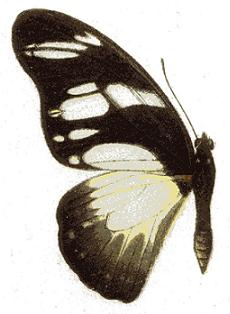
Graphium almansor, the Almansor white-lady swordtail or Honrath's white lady, is a butterfly in the family Papilionidae (swallowtails). It is found in Guinea, Ghana, Togo, Nigeria, Cameroon, the Republic of the Congo, Angola, the Central African Republic, the Democratic Republic of the Congo, Sudan, Ethiopia, Uganda, Kenya, Tanzania, Zambia and possibly Rwanda and Burundi.
Graphium ucalegonides is a butterfly in the family Papilionidae (swallowtails). It is found in Cameroon, the Republic of the Congo, northern Angola, the Democratic Republic of the Congo and Chad.

















